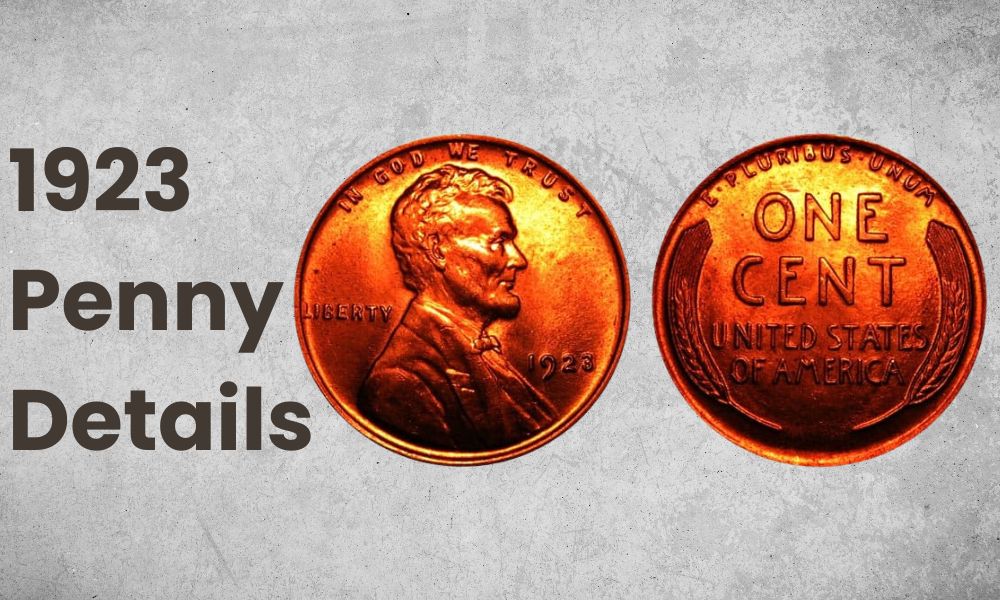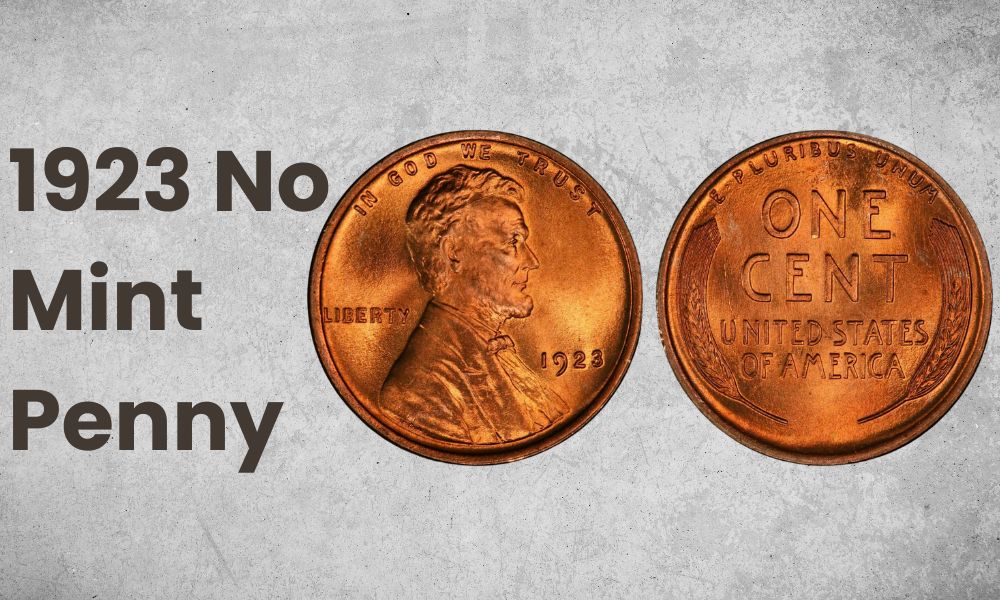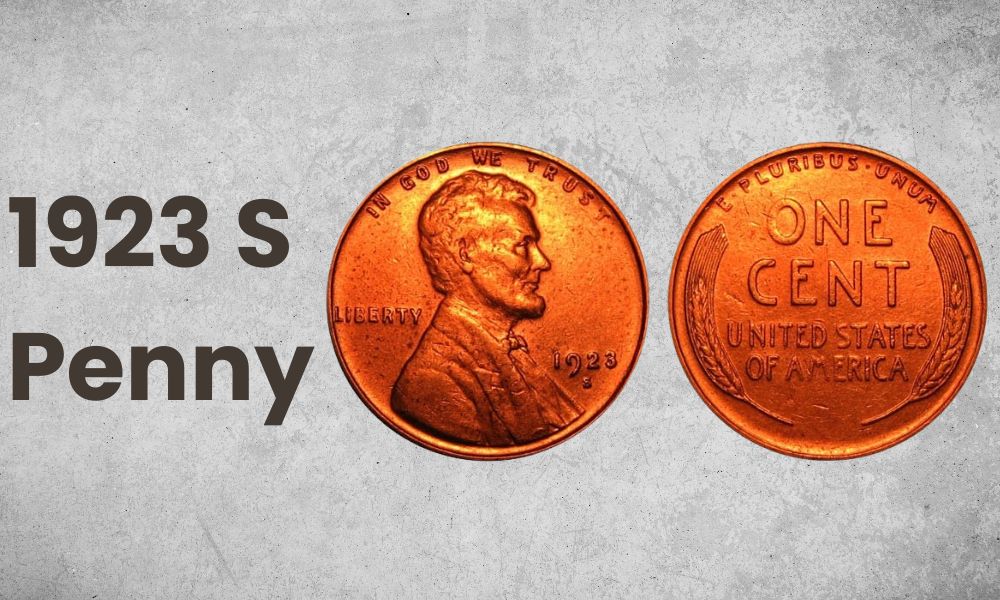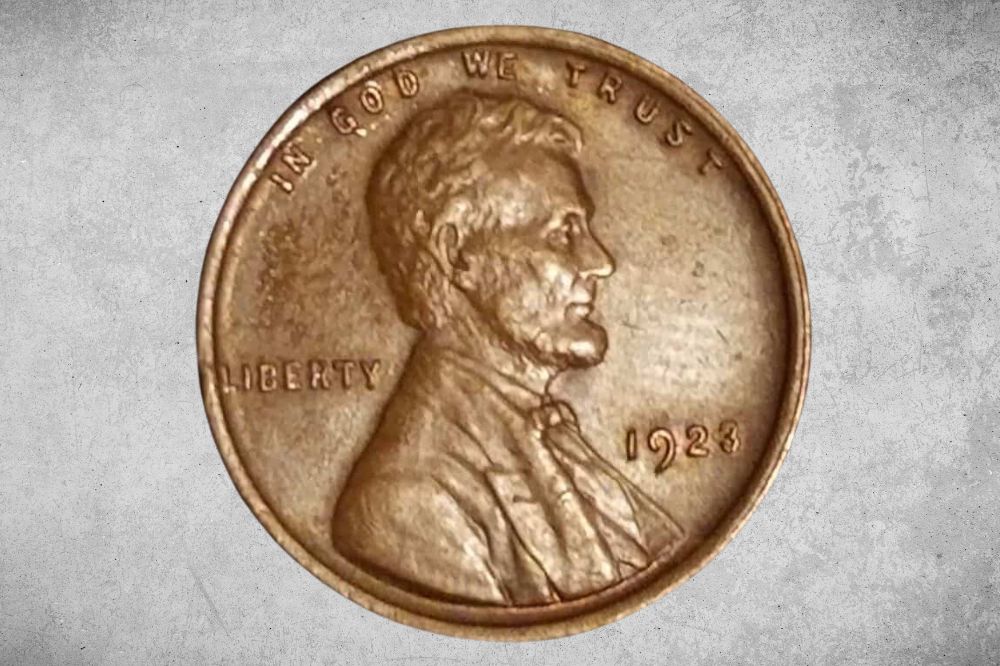The face value of the 1923 Penny is not that high, but we know you are not here because of that. Most coins are not that much valuable, anyway.
But what is valuable is the story that each of them has, the design that each of them features, and the feeling of excitement when you either see or hold a coin in your hand.
Unfortunately, we can not give you a 1923 Penny to hold, but we can tell you everything that makes it unique and a collection-worthy.
1923 Penny Details

- Category: Wheat Penny (1909 – Present)
- Mint(s): Philadephia, San Francisco
- Mintage: 83,423,000
- Obverse Designer: Victor D Brenner
- Reverse Designer: Victor D Brenner
- Face Value: $0.01 (One cent)
- Composition: 95% Copper – 5% Tin and Zinc
- Weight: 0.109 oz (3.11 g)
- Diameter: 0.748 inches (19 mm)
- Thickness: 0.076 inches (1.95 mm)
- Edge: Plain
Obverse
Anyone who has ever seen the penny even once knows why it is so popular – it features a portrait of the United States 16th president, Abraham Lincoln.
The penny, which started being produced in 1909, had the honor of being the first coin to not only have a depiction of a former president but also any real person.
The obverse of the penny or the Lincoln cent, which is its official name, features 4 more details. On the left side of the coin, at the height of the middle of the coin, is the writing LIBERTY, which is a popular motif in the USA featured on all their coins since 1792, either as a drawing or writing, or both.
The official motto of the USA, IN GOD WE TRUST, is placed on the top rim of the 1923 Penny.
The lower right side of this coin has the last two details: the year of minting, 1923, and the mint mark, engrained below the year.
Since the coins struck at the mint in Philadelphia at the time usually did not have the mint mark P, and the 1923 Penny was not minted in Denver at all, you can only find these cents with the mint mark S.
Reverse
If we do not count the mint mark, both sides have 4 details.
On the reverse, the most prominent one is probably the denomination, ONE CENT, which is placed in the center of the coin’s upper half. The bottom half features the writing UNITED STATES OF AMERICA.
The last two details are the wheat stalks, symbols of abundance, fertility, and prosperity, placed on both side rims of the coin, and the inspiration E PLURIBUS UNUM. It is the traditional motto of the United States, which, translated from Latin, means “Out of many, one”.
By the way, the Lincoln cent is also known as the Wheat Penny because of the aforementioned wheat stalks.
Other Info
The 1923 Penny is almost all made out of copper (95%), with the rest being the work of tin and zinc, which is why it is reddish brown.
Being the second smallest denomination ever minted in the US (the smallest one is the half-cent), the 1923 Penny is not a particularly big or heavy coin with its diameter of 0.74803 inches (19 mm) and weight of 0.109 ounces (3.11 g).
Another advantage or disadvantage of being the second smallest denomination (depending on the angle you look at it from) is that probably no one will think of making counterfeits of you.
For this reason, the Lincoln cent does not have a reeded edge, which is an anti-counterfeit measure, but the plain one.
1923 Penny Value Chart |
|||||||
| Mint Mark | Good | Very Good | Fine | Extra Fıne | AU | MS60 | MS65 |
| 1923 No Mint Mark Penny | $0.5 | $0.6 | $0.8 | $6.1 | $11 | $19 | $36 |
| 1923 S Penny | $5.1 | $7 | $9.2 | $48 | $107 | $248 | $442 |
1923 Penny Value And Varieties Guide
Following two years, when the production of the Lincoln cent was really low, the US Mint decided to start striking this coin in huge amounts, which is why its mintage rose from 7,160,000 in 1922 to 83,423,000 in 1923.
An interesting thing about the pennies from this year is that they were minted at two places, Philadelphia and San Francisco. The mint in Denver was busy dealing with silver and gold and turning these precious metals into golden double eagles worth $20 and silver dollars.
Still, we have the coins from Philly and San Fran, as we said, so let’s take a look at their values!
1923 No Mint Penny Value

- Type: Wheat Penny
- Mint: Philadephia
- Mint Mark: No Mint Mark
- Mintage: 74,723,000
- Designer: Victor D Brenner
- Face Value: $0.01 (One cent)
- Composition: 95% Copper – 5% Tin and Zinc
- Weight: 0.109 oz (3.11 g)
- Diameter: 0.74803 inches (19 mm)
- Thickness: 0.07677 inches (1.95 mm)
- Edge: Plain
Most of the 1923 Pennies that were released into circulation were produced at the mint in Philadelphia – 74,723,000, to be precise, making them not so uncommon.
1923 No Miny Pennies in a good, very good, or fine state are not worth much since you will earn less than a dollar for one. Things start to look better in the Extra Fine category because a specimen of 1923 Penny of this type is valued at more than 6 dollars.
About/almost uncirculated pennies will make you almost 20 dollars, and the ones in mint state 65 are around 65 dollars. Yeah, we know it s not much, but still, it is better than nothing.
The highest that a 1923 Wheat Penny was ever sold for is $11,500, and it actually happened twice – once in 2005 and the other time the year after that.
One last thing we should discuss concerns not only 1923 No Mint Lincoln Cents but all coins made out of (mostly) copper: they can be found in three coloration types: red, red-brown, and brown.
The most preserved ones will, of course, be red and glossy and are worth the most, while the ones that have changed millions of hands and pockets will be brown and are, of, hmm, questionable value.
Hopefully, you have some of those shiny ones in your possession!
1923 S Penny Value

- Type: Wheat Penny
- Mint: San Francisco
- Mint Mark: S
- Mintage: 8,700,000
- Designer: Victor D Brenner
- Face Value: $0.01 (One cent)
- Composition: 95% Copper – 5% Tin and Zinc
- Weight: 0.109 oz (3.11 g)
- Diameter: 0.74803 inches (19 mm)
- Thickness: 0.07677 inches (1.95 mm)
- Edge: Plain
Only around 10% of the 1923 Wheat Pennies’ mintage was the work of mint in San Francisco, making the 1923 S Wheat Pennies much more valuable than their siblings from Philadelphia. Expect to earn $5, $7, and $9 for those that are in Good, Very Good, or Fine state, respectively.
Extra Fine ones are almost 50 dollars worth, while the About/almost uncirculated specimens are close to 110 dollars in value.
The situation is the same when we look at auctions – 1923 S Pennies are worth tens of thousands of dollars even in mint state 65.
If you have one that is also red, well, you should know that the highest price that a specimen of this category reached in an auction is almost 68,000 dollars.
Also Read: Top 20 Most Valuable Old Pennies Worth Money (Penny Collection)
1923 Penny History
If you read the parts about the obverse and reverse, you may have noticed that we did not mention the designer’s initials anywhere. As a lot of you probably know, almost all coins feature their designer’s initials. So, why does Lincoln cent not have them?
Well, it actually did have them in the first original version of this coin which was even struck in almost 29 million copies. However, the public thought that the letters VDB, which are the initials of the coin designer, Victor D Brenner, were taking up too much space on the reverse.
Upon hearing these grumblings, US Treasury officials decided to change the design. They had two options: completely erasing the initials or leaving only the letter “B” in a smaller font.
Because the coin production had already started, they had to make a quick decision. Removing the initials totally was the less time-consuming option, so they opted for the no-initials redesign.
But we are getting ahead of ourselves! Let’s go back to the beginning!
The story of the Lincoln cent or Wheat Penny starts with the former president of the United States, Theodore Roosevelt, who felt like the coinage at the time was not as beautiful and artful as it could be. He even wrote a letter in 1904 to the US Treasury mentioning this.
Roosevelt wanted the sculptor Augustus Saint-Gaudens to be the person in charge of redesigning the US coinage and got his wish fulfilled since Saint-Gaudens would go on to redo the designs of the double eagle ($20), eagle ($10), half eagle ($5), and quarter eagle ($2.50) in 1907.
Unfortunately, he had cancer at the time and died without making a design for the new cent that the US Treasury liked.
Almost a year and a half would pass without anything noteworthy happening. However, towards the end of 1908, Roosevelt met with the aforementioned Victor D Brenner and sat for him while he was designing a medal.
Although there are no records of what they talked about during this meeting, soon after it, the US Mint approached Brenner and inquired him about designing the one cent. Brenner accepted their offer.
Why did Roosevelt choose Brenner, you might ask?
Well, since 1909 marks the 100th year of Lincoln’s birthyear, there was a lot of talk about commemorating him through souvenirs. There were those who wanted the portrait of the former president to appear on a US coin, which was an idea Roosevelt was in favor of.
Brenner had made a plaque of Abraham Lincoln in 1907, and guess who liked it? Yes, Theodore Roosevelt! According to the sculptor, the then-president even mentioned this to Brenner during their meeting.
Brenner produced a memorable design that was used for 100 years. In 2009, however, The US Treasury decided to honor Abraham Lincoln once again, this time for the bicentennial of his birth year.
Since the Lincoln cent is still being used today, it is the longest-running coin in the US.
1923 Penny Grading
If you would like to learn how to grade a 1923 Penny, please watch this video!
1923 Penny List Of Errors
There is probably nothing that coin collectors like more than mint errors. Well, maybe coins in pristine condition? Or coins in pristine conditions with rare errors?
It is hard to decide. But in any case, we will talk about two errors that the 1923 Penny can be found.
1. 1923 Penny Uncentered Broadstrike Error
This type of error happens when the planchet onto which the design will be struck is not in the proper place. Unfortunately for the mints, but fortunately for numismatists, the coins minted this way will not have the complete design on themselves.
By the way, a coin with this error taking around 10% of the surface on the bottom and the left side was sold for more than $50.
2. 1923 Penny Struck-Through Thread On The Obverse Error
The other mistake we will mention is an interesting one. On the bottom half of the obverse, you can see a thread from Lincoln’s shoulder towards his chest which somehow made its way onto the die and was struck through.
This error is rarer than the one we previously discussed, which is why one specimen with it was sold for more than $150.
1923 Penny FAQ
How rare are 1923 Pennies?
1923 Pennies are not that rare since almost 84 million of them were produced. If you wonder which variety of 1923 is rarer, the answer is 1923 S Penny because there are almost 9 times more coins that came from the mint in Philadelphia.
As is the case with most coins, the rarest ones are those with some kind of mint error.
What are 1923 Pennies worth?
The 1923 Pennies’ worth depends on their condition. For example, a 1923 No Mint Mark Penny in good condition is worth just half a dollar, while the 1923 S Penny is around 5 dollars.
In mint state 65, for example, 1923 S Penny will get you at least 400 dollars! The No Mint mark specimen in the same condition, on the other hand, is worth close to 40 dollars.

I have a 1923 reddish brown penny error how can I get it sold and hoe much can I sell it for